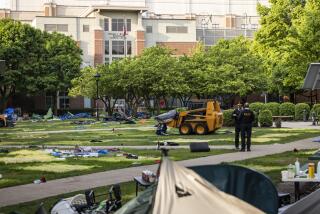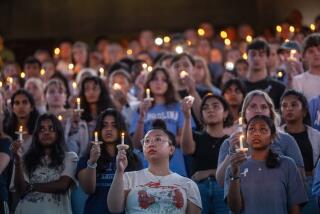Gang-Rape Allegations Roil Duke, Durham
- Share via
DURHAM, N.C. — The campus of Duke University has been awash in protests and soul-searching over allegations from a police investigation involving the school lacrosse team: that a black exotic dancer performed at a party attended by members of the team, most of whom are white; that the party grew rowdy and racial slurs were uttered; and that she was cornered, choked and gang-raped.
Across town at North Carolina Central University -- the historically black college where the alleged victim is enrolled -- some see remnants of a mind-set more aligned with the Old South.
Professor Isaac Robinson, 65, an African American who teaches in the department of social work, said the alleged attack is “part of a historical pattern I understand perfectly well. I am the last generation who remembers the era of American apartheid. Part of that was the absolute defenselessness of black women, where their families, their husbands, their relatives couldn’t protect them in the white community.”
Police have filed no charges in the March 13 incident, and the captains of Duke’s lacrosse team -- a top contender for the Division I national title -- have issued a statement calling the rape allegations “totally and transparently false.”
Nonetheless, the allegations have reawakened uncomfortable issues of race and class that have long defined Durham, a historic Southern textile and tobacco hub with a population of 187,000 that is also home to one of the nation’s most prestigious private universities.
On the Duke campus, the incident has sparked intense discussion about the rights of the accused, the problem of boorish behavior among top-tier athletes and the prevalence of sexual assault. It has also prompted examination of just how far Duke has come since the all-white campus integrated in 1963.
But officials are also hoping that it does not unravel the years of work done to reach beyond their sprawling wooded campus into the community of Durham itself.
“There’s a wonderful line from ‘I, Claudius’: ‘Let all of the poisons that lurk in the mud out,’ ” said Duke Senior Vice President John F. Burness. “There are people at Duke who work here now whose fathers and mothers and uncles and aunts worked here when it was a segregated institution. Imagine the stories they must have brought home. And now all of that is coming back.”
The accuser gave police the following account of the evening, according to court documents:
She and another exotic dancer met just east of campus at a house that is home to three lacrosse team co-captains. The dancers began their routine, but the men became “excited and aggressive,” and the women left. But they were convinced by one of the men to go back inside. Shortly afterward, the accuser was separated from her friend, then pulled into a bathroom, held by her legs and arms, and raped for about 30 minutes by three men.
In a press release issued Wednesday, police said the dancer was robbed of a cellphone and cash before she fled the house.
A next-door neighbor, Jason Bissey, 26, said Thursday that he was on his front porch that night. Bissey said he saw some men from the party milling outside. He said he also saw two women speed off in a car. As they left, he said, one man shouted, “Thank your grandpa for my nice cotton shirt!”
Police also released a tape of a 911 call made that evening in which a female caller said that she and a friend were walking near the house when a man there yelled a racial slur at them. Two of the attorneys representing the lacrosse team members would not comment Thursday when contacted by The Times, but in speaking to other media Wednesday they questioned the 911 tape’s accuracy.
Police said that 46 members of the lacrosse team had provided DNA samples and that the results were expected next week. The team members who provided samples were all white. One black member was not tested because the dancer said only white men assaulted her.
This week, Duke University President Richard H. Brodhead suspended the team from play, but demonstrations continued to roil the campus. On Wednesday, hundreds of students and others joined an emotional march through campus that had been previously scheduled as part of Sexual Assault Prevention Week. Some issued lists of the lacrosse players’ names, according to the Chronicle, Duke’s student newspaper.
On Thursday morning, Brodhead called a closed-door meeting with black leaders, including Durham Mayor Bill Bell and North Carolina Central Chancellor James Ammons.
Burness said they discussed the impact of the allegations on Durham, and on Duke’s relationship with residents. Some of the people in the meeting told Brodhead that there was still a feeling of elitism that separated Duke from the community.
It is nothing new. For decades in Durham, blue-collar and rural workers have shared the streets with scholars drawn to Duke. The school attracted top academics from better-known Northeastern schools as early as the 1890s, when it was known as Trinity College.
The college benefited from the financial support of the Dukes, a family of wealthy Methodist tobacco planters. The soaring, neo-Gothic chapel that is Duke’s defining icon was a source of local pride.
“I grew up here, and you’ve got to understand that this was just a little Southern tobacco town, but then you had this elegant university,” Robinson said.
Today, stark economic realities remain: Yearly tuition at Duke will be $43,000 in the fall. In Durham, according to the 2000 census, the median household income was $41,160.
Burness said Duke had become increasingly concerned about the gulf between school and city, and has been reaching out to the community in earnest since the mid-1990s. University leaders realized that with the textile and tobacco industries waning, the university, as the largest economic engine remaining in the area, needed to become more active in the community.
Since then, the university has helped raise $12 million for improvements to a dozen nearby neighborhoods. Duke’s outreach program has helped build and renovate homes, subsidized a program to increase homeownership, opened health clinics and operated after-school programs.
Today, Burness said, 35% of undergraduate students at Duke are minorities, and the school works hard to ensure that they feel comfortable. Doha Mekki, a black junior at Duke, said the school had done a good job.
“I think because Duke has had a long history of racial exclusion, the tendency [of outsiders] is to see it as a racist institution, but that’s just not the case,” she said.
Ammons said the ties between his school and Duke went back further than a decade: The Duke family made major contributions to Carolina Central in the 1920s.
Duke’s more recent efforts have helped its standing in the broader community, including among the African Americans who make up 44% of Durham’s population.
But he worried how much could be undone by one Monday night party.
“If these allegations are proven true, this will set us back many, many, many years.”
Times researcher John Beckham in Chicago contributed to this report.
More to Read
Sign up for Essential California
The most important California stories and recommendations in your inbox every morning.
You may occasionally receive promotional content from the Los Angeles Times.













